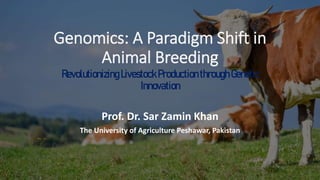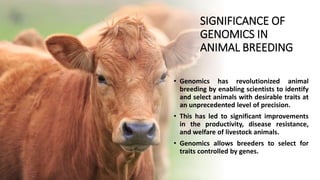Role of Modren Genomics in Animal Productions.pptx
- 1. Genomics: A Paradigm Shift in Animal Breeding RevolutionizingLivestockProductionthroughGenetic Innovation Prof. Dr. Sar Zamin Khan The University of Agriculture Peshawar, Pakistan
- 2. BACKGROUND • Figure : Global demand for meat in 2050 (adapted from FAO, 2012; Gates Notes 2013) • With a projected world population of nearly 10 billion people by 2050, an unprecedented increase in demand for animal protein is inevitable. • The gap between animal production and the world's population's demand is widening. As the population grows, so does the demand for meat, dairy, and eggs.
- 3. BACKGROUND However, animal production is not keeping up with this demand. This is due to a number of factors, including: 1. Environmental constraints: Animal agriculture is a major contributor to environmental degradation, including deforestation, water pollution, and greenhouse gas emissions. As the world becomes more concerned about the environment, there is pressure to reduce animal production.
- 4. BACKGROUND • Rising costs of feed: • The cost of feed, which is the main input for animal production, has been rising in recent years. This is due to several factors, including climate change, which has reduced crop yields, and the increasing demand for biofuels, which has diverted land away from food production
- 5. BACKGROUND https://www.researchgate.net/figure/Global-demand-for-meat-in-2050- adapted-from-FAO-2012-Gates-Notes-2013_fig2_280489567 [accessed 14 Nov, 2023] So there is an imperative need to explore new technologies through which productive traits of animals could be modified in order to meet world’s demand for milk, meat and eggs.
- 6. BACKGROUND • The use of genomics is leading to a paradigm shift in animal breeding. This shift is away from traditional methods of selection based on phenotypic recordings and towards a new era of selection based on genetics. • This led to the development of animals that are more productive, healthier, and have better welfare.
- 7. What is genomics? • Genomics is the study of all of an organism's genes, including their structure, function, and evolution. It is a broad field that encompasses a wide range of research activities, from sequencing individual genes to analysing the entire genome of an organism.
- 8. GENOMICS IN ANIMAL BREEDING Genomics is revolutionizing animal breeding by providing breeders with new tools to select animals with desired traits This is done by analyzing the DNA of animals and identifying genetic markers that are associated with desired traits
- 9. Steps of genomics in animal breeding Identify a reference population 1 Genotype animals in the breeding population 2 Use the prediction equations to estimate the breeding values of the animals in the breeding population 3 Select animals with the highest breeding values for the traits of interest 4
- 10. ADVANTAGES OF GENOMICS IN ANIMAL BREEDING â—Ź More accurate selection, considers all genes affecting traits â—Ź Faster selection, choose at younger age â—Ź Rapid improvement in genetic quality
- 11. SIGNIFICANCE OF GENOMICS IN ANIMAL BREEDING • Genomics has revolutionized animal breeding by enabling scientists to identify and select animals with desirable traits at an unprecedented level of precision. • This has led to significant improvements in the productivity, disease resistance, and welfare of livestock animals. • Genomics allows breeders to select for traits controlled by genes.
- 12. Genomics vs Traditional Breeding • Genomics • a more sophisticated approach to animal breeding that relies on the analysis of an animal's DNA • More precise • High ability to develop new breeds • Relatively expensive • Traditional Breeding • Based on the selection of individuals with desirable traits for breeding purposes • Less precise • Limited ability • Less expensive
- 14. APPLICATIONS OF GENOMICS IN ANIMAL BREEDING • Genomics is being used to improve a wide range of traits in animals, including: 1. PRODUCTION TRAITS a. Milk production in cows b. Egg production in chickens c. Meat production in livestock animals.
- 15. APPLICATIONS OF GENOMICS IN ANIMAL BREEDING 2. Health Traits a. Resistance to disease b. Tolerance to heat stress This Photo by Unknown Author is licensed under CC BY-NC-ND
- 16. APPLICATIONS OF GENOMICS IN ANIMAL BREEDING 3. Animal Welfare a. Behavior and temperament. This Photo by Unknown Author is licensed under CC BY-SA
- 17. APPLICATIONS OF GENOMICS IN ANIMAL BREEDING 4. Developing New Breeds • Genomics can be used to identify and select animals with desirable traits that are not found in existing breeds.
- 18. APPLICATIONS OF GENOMICS IN ANIMAL BREEDING 5. Preserving Genetic Diversity Genomics can be used to identify and preserve rare breeds of animals.
- 19. EXAMPLES OF GENOMICS IN DOMESTIC ANIMALS • 1. In dairy cows, genomics is being used to select for animals that a. Produces more milk, b. Have higher butterfat content, c. More resistant to mastitis.
- 20. Examples of genomics in domestic animals 2. In pigs, genomics is being used to select for animals that • a. Grow faster • b. Have more lean meat • c. More resistant to diseases such as PRRS (Porcine Reproductive and Respiratory Syndrome).
- 21. Examples of genomics in domestic animals • 3. In chickens, genomics is being used to select for animals that a. lay more eggs b. have better feed efficiency c. more resistant to diseases such as Newcastle disease.
- 22. OPPORTUNITIE S OF GENOMICS IN ANIMAL BREEDING 1. Increased genetic gain 2. Reduced costs 3. improved animal welfare 4. Reduced environmental impact 5. Increased profits for farmers
- 23. CHALLENGES 1. High cost of genotyping 2. Need for large reference populations 3. Computational challenges 4. Ethical concerns
- 24. conclusion • The use of genomics in animal breeding is still in its early stages of development, but it has the potential to significantly improve the efficiency, sustainability, and ethics of animal production.
- 25. • The future directions of genomics in animal breeding are exciting and have the potential to make a real difference in the world.
- 27. THANK YOU
Editor's Notes
- #10: Identify a reference population: This is a group of animals that have been phenotyped (measured for the traits of interest) and genotyped (their DNA has been sequenced). The reference population is used to develop prediction equations that link genetic markers to phenotypes. Genotype animals in the breeding population: This involves sequencing the DNA of the animals in the breeding population and identifying their genotypes at the genetic markers of interest. Use the prediction equations to estimate the breeding values of the animals in the breeding population: The breeding value of an animal is an estimate of its genetic merit for a particular trait. It is calculated by taking into account the animal's genotype and the genotypes of its relatives in the reference population. Select animals with the highest breeding values for the traits of interest: These animals are then mated to produce the next generation of offspring
- #15: 1. Increased Productivity Genomics allows breeders to select animals that have a higher genetic predisposition for desirable traits such as increased milk production, faster growth rates, and improved feed efficiency. This can lead to significant increases in productivity and profitability for livestock producers.
- #16: 2. Improved Disease Resistance By analysing an animal's DNA, scientists can identify genetic markers associated with disease resistance. This information can be used to select animals that are less likely to develop diseases such as mastitis in cows, Newcastle disease in chickens, and PRRS (Porcine Reproductive and Respiratory Syndrome) in pigs. This can reduce the need for antibiotics and other medications, improve animal welfare, and reduce the risk of drug-resistant bacteria.
- #17: 3. animal welfare Genomics can be used to select animals that have desirable traits that contribute to their overall welfare, such as good temperament, strong legs, and resistance to heat stress. This can improve the overall welfare of livestock animals and reduce the need for painful interventions such as tail docking or beak trimming.
- #18: 4. Developing New Breeds Genomics can be used to identify and select animals with desirable traits that are not found in existing breeds. This can lead to the development of new breeds of animals that are better suited to specific production environments or consumer demands.
- #19: This can help to maintain genetic diversity and ensure that we do not lose valuable genetic resources
- #23: Increased genetic gain: Genomics can help breeders to select animals with the desired traits more accurately and efficiently than traditional breeding methods. This can lead to increased genetic gain for important traits such as growth rate, feed efficiency, disease resistance, and product quality. Reduced costs: Genomics can help to reduce the costs of animal breeding by reducing the need for expensive phenotyping (measurement of traits). Improved animal welfare: Genomics can be used to select animals that are more resistant to diseases and that have a better temperament. This can lead to improved animal welfare. Reduced environmental impact: Genomics can be used to select animals that are more feed efficient and that produce less manure. This can help to reduce the environmental impact of animal agriculture. Increased profits for farmers: By using genomics to select animals with the desired traits, farmers can produce more meat, milk, and eggs at a lower cost. This can lead to increased profits for farmers.
- #24: High cost of genotyping: The cost of genotyping animals is still relatively high, but it is decreasing rapidly. Need for large reference populations: To develop accurate prediction equations, a large reference population is needed. This can be difficult and expensive to establish for some species or breeds. Computational challenges: Analyzing genomic data can be computationally challenging, especially for large populations. Ethical concerns: There are some ethical concerns associated with the use of genomics in animal breeding, such as the potential for unintended consequences.





![BACKGROUND
https://www.researchgate.net/figure/Global-demand-for-meat-in-2050-
adapted-from-FAO-2012-Gates-Notes-2013_fig2_280489567 [accessed 14
Nov, 2023]
So there is an imperative need
to explore new technologies
through which productive traits
of animals could be modified in
order to meet world’s demand
for milk, meat and eggs.](https://image.slidesharecdn.com/roleofmodrengenomicsinanimalproductions-231129092307-75c90464/85/Role-of-Modren-Genomics-in-Animal-Productions-pptx-5-320.jpg)





















